Third Quarter 2022 Currency Outlook
Despite weakening demand from a cyclical slowdown, Central Banks are aggressively attempting to curb inflation by hiking rates. The Federal Reserve changed course from 50 basis points (bp) to 75bp in June after inflation came in hotter than expected. The Swiss National Bank and the Reserve Bank of Australia also raised rates higher than expect at 50 bp. The European Central Bank (ECB) not be outdone looks to be joining the party as the market is now priced in 100bp of hikes into year-end. The Bank of England was more measured at 25bp but warned of more dramatic hikes if necessary. The Bank of Canada raised rates 100bp in July. Only the Bank of Japan is maintaining “extremely low interest rates.” Currencies have recovered against the U.S. Dollar as a result. Calls for 100bp hike in July followed the strong June U.S. jobs report, Consumer Price Index (CPI) at 9.1%, and comments by the Federal Reserve that believes that a tight job market can withstand additional hikes. Regardless, the medium-term trend for U.S. Dollar strength is intact, and could continue after the Fed meets in July and decides to raise another 75bp or 100bp. During the editing of this outlook, EUR/USD was 1.0600 and sunk 5.6%, requiring an entire re-write to my view. The market now will focus on GDP growth (or negative growth) along with inflation for clues on what the Fed will do going forward. Even a small negative GDP number may be enough to keep the Fed on track to be more aggressive in fighting inflation. Another negative quarter of growth would be a recession and may ultimately lead to political pressure to decrease hikes. Vladimir Putin is taking a more measured approach to the Ukraine War and has begun a new bombing campaign of Kiev. Russia has lost so many generals during the conflict that Putin has pulled one off the retirement bench to lead the conflict. The “media talking heads” think Putin will be satisfied with annexing only the Donbas region, his actions seem to indicate he is dug in for the long haul. Putin is facing very little pressure from citizens, and oil is still very affordable there, unlike the rest of the world. This should keep downward pressure on EUR for the foreseeable future.
EURUSD (Bearish)
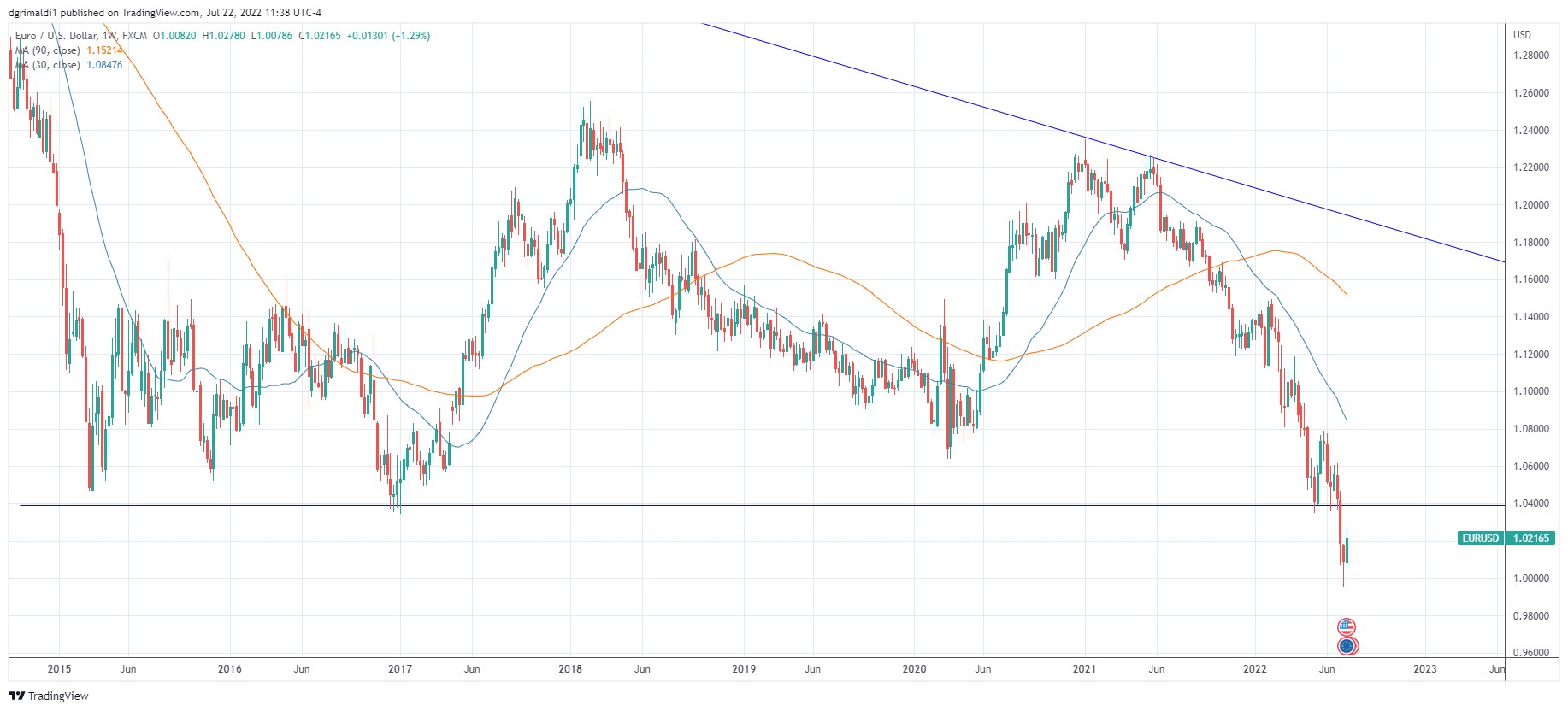
EUR/USD has broken support now 1.0325-50 and traded to parity on July 12. The summer months are normally very quiet for FX activity, but these are not normal times. After a good U.S. Labor report the market seems convinced of a more aggressive Fed, and recession in Europe. The technical bearish call I have held to since September 2021 is still performing well and should continue unless the U.S. goes into a recession. Pricing is getting further from moving average, which should provide good selling opportunities on rallies. I would expect 1.0800 now to hold this year on rallies. The break below 1.0300 brought more selling pressure and as will a break of 1.0000. Downside target now is .9325 and .8900 channel support. The Ukraine War is far from over, and we should not underestimate the atrocities Putin will inflict to capture areas they retreated from earlier this year.
USD JPY (Neutral/Bullish)
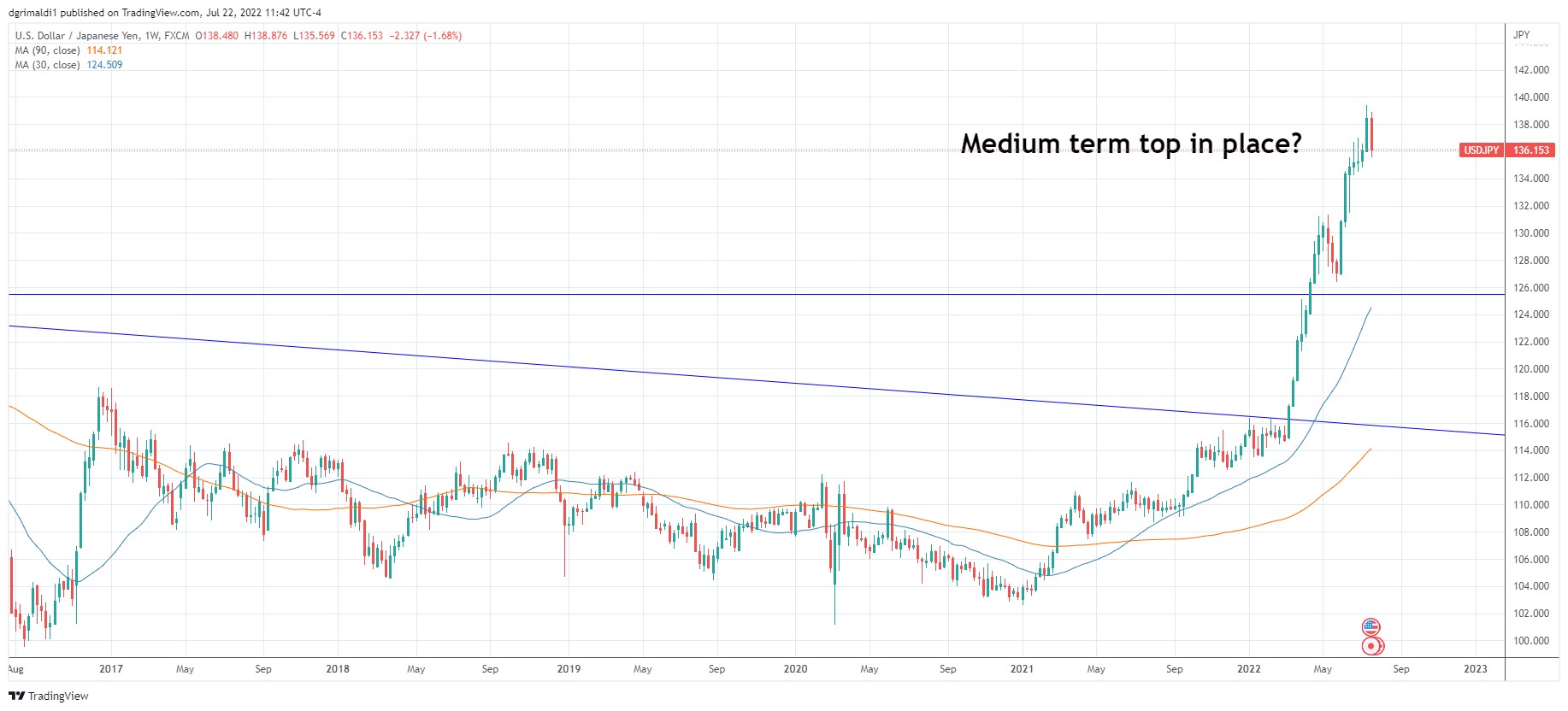
The Bank of Japan (BoJ) seems to be the only Central Bank that feels inflation is transitory. While they remain extremely accommodative on interest rates every other major economy is hiking rates. The BoJ has not intervened in the market to-date to protect the Japanese Yen, but they are aggressively defending their implicit 0.25% cap for the 10-Year bond (JGB’s) yield target with bond purchases. For an economy that is heavily dependent on oil and raw materials, the weak Yen policy has a negative impact on their businesses. Historically, the Central Bank will usually intervene above 140.00 USD/JPY, levels we have not seen since the 1990’s. The last time we saw a defense of their currency was back in 2011 during the Fukishima nuclear disaster, and that was when they were selling JPY. The defense of 75.00 USD/JPY lasted more than two years and was eventually successful. If the Central Bank does have a level to defend, I would expect the same kind of all in defense, and historically the BoJ never loses this battle. USD/JPY will be bullish unless U.S. policy changes on rates and we are heading into a recession. If the U.S. is still raising rates and the Japanese central bank starts defending the Yen, I would expect the upward climb to stop and volatility to drop for an extended period. As I finish writing this, USD/JPY has seen some pull back to 135.80 level after the BoJ policy announcement, so some pricing in of a possible U.S. recession could be the justification for this move.
GBPUSD (Bearish)
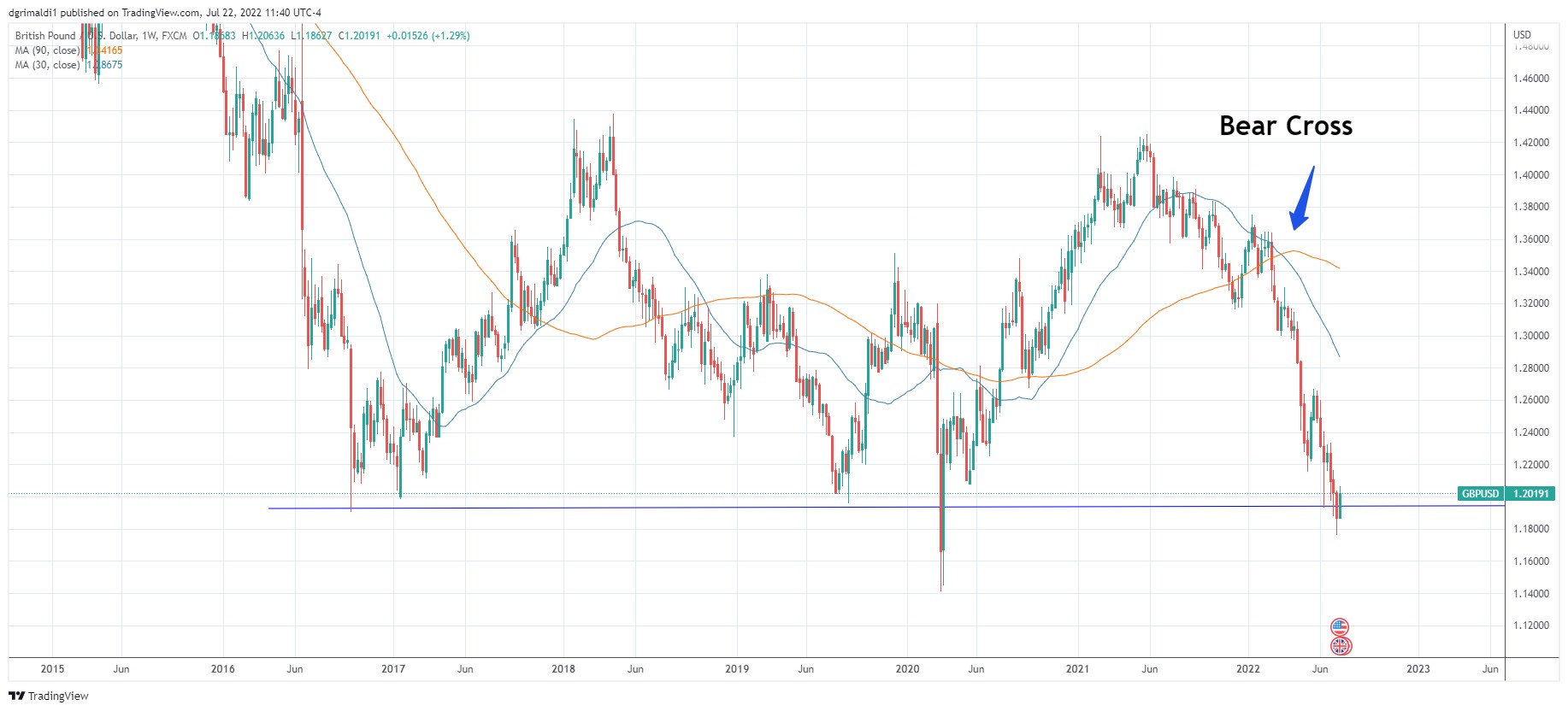
Inflation in the United Kingdom headed toward 10% as the oil crunch and supply chain woes make a costly impact. The Bank of England (BoE) raised rates for the fifth time and now some of the more hawkish members want faster rate hikes. At the last policy meeting in June, the BoE is prepared to act more forcefully to tame inflation. Prime Minister Boris Johnson has resigned as PM and will step down once a replacement is found. Investors are betting on a rate hike of 50bp in August to 1.25%. That could change now that the Bank of Canada has hiked 100bp and the Fed is rumored to do likewise. From a technical standpoint, GBP prices have now broken down since April and are starting to make some separation from the moving averages. On the monthly chart it looks like a close below 1.2160 would accelerate prices to the downside and could target 1.1300 area that held during Brexit in 2015 and COVID in March 2020.
AUDUSD (Neutral/Bearish)
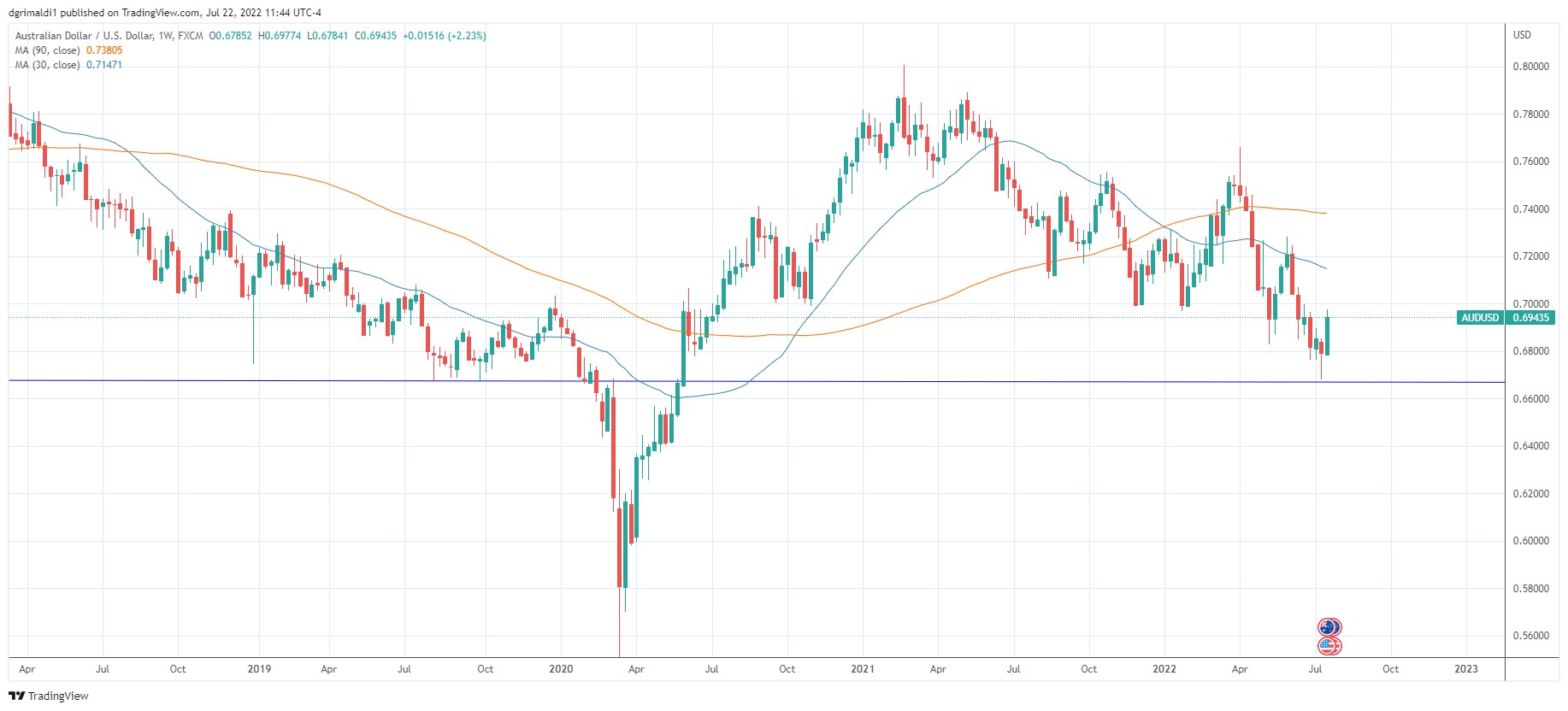
Growth prospects for late 2022 and 2023 took a hit with China lockdowns and a more aggressive policy stance by the Royal Bank of Australia. Growth predictions have been lowered from GDP at 4.7% to 3.5%. and 2.1% in 2023. Expectations are for another half point increase this summer to 1.35%, with the rate heading to 2.1% at year-end. The inflation rate is expected to peak at 6.25%, far below other western countries due to the harsh lockdown policies, and dependence on China trade and commodities. AUD/USD technical are starting to look more bearish, as I have been more neutral with this pair in 2022. There is some separation in prices from the moving average, but the caveat is there is no bearish cross in the averages and no downward slope. A monthly close below .6650 may see a further breakdown in prices. My preference would to be short, but the weekly chart is not the best setup for that position.
USDCAD (Neutral/Bullish)
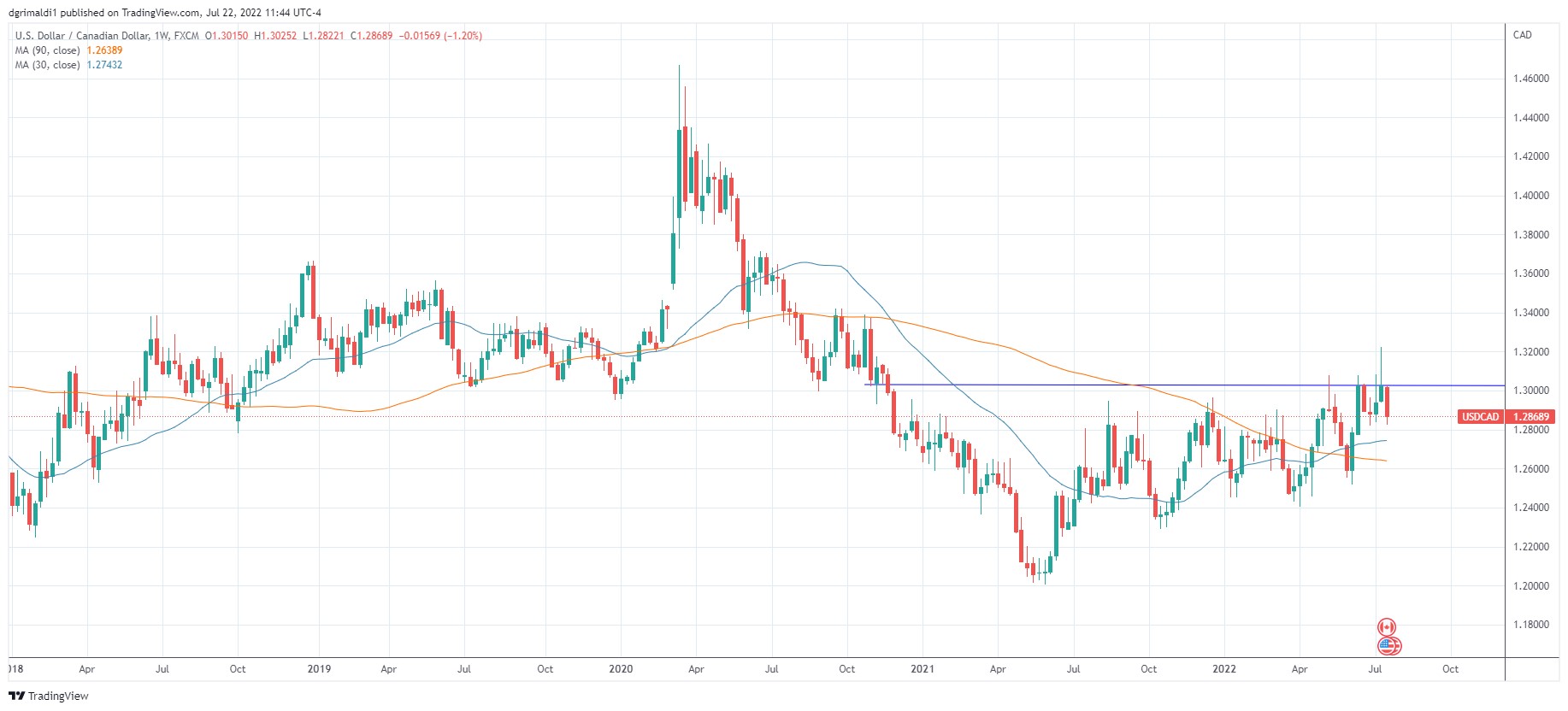
The Canadian inflation rate ballooned to 7.7% in May from 6.8% in April. The Bank of Canada pledge to be “more forceful” in the fight to curb inflation. They raised rates 50bp in June, and surprised markets with 100bp hike in July to 2.5%. “With the economy clearly in excess demand, inflation high and broadening, and more businesses and consumers expecting high inflation to persist for longer, the Governing Council decided to front-load the path to higher interest rates,” officials said in the policy statement. The Bank of Canada, like the Federal Reserve Bank, has not acted despite inflation tracking above the central banks 2% inflation target for 15 months. Some are calling for rates above 3.75% by year-end to slow down inflation, which should in turn slow economic activity. On the technical front, USD/CAD is bullish due to risk off environment with the Ukraine War and equities. I would like to see a weekly close above 1.3030 on the month to get me off neutral. Canada’s main export is oil, so with increasing oil prices, CAD gets stronger. As global oil demand has slowed due to additional lockdowns in China, oil prices have slipped, and the U.S. dollar has gained versus CAD. If the U.S. goes into recession, we could see a reversal of U.S. dollar bullishness. Also, the moving averages are not sloping upward, they are mostly flat, keeping my view neutral for now.
USD/RUB (Bearish)
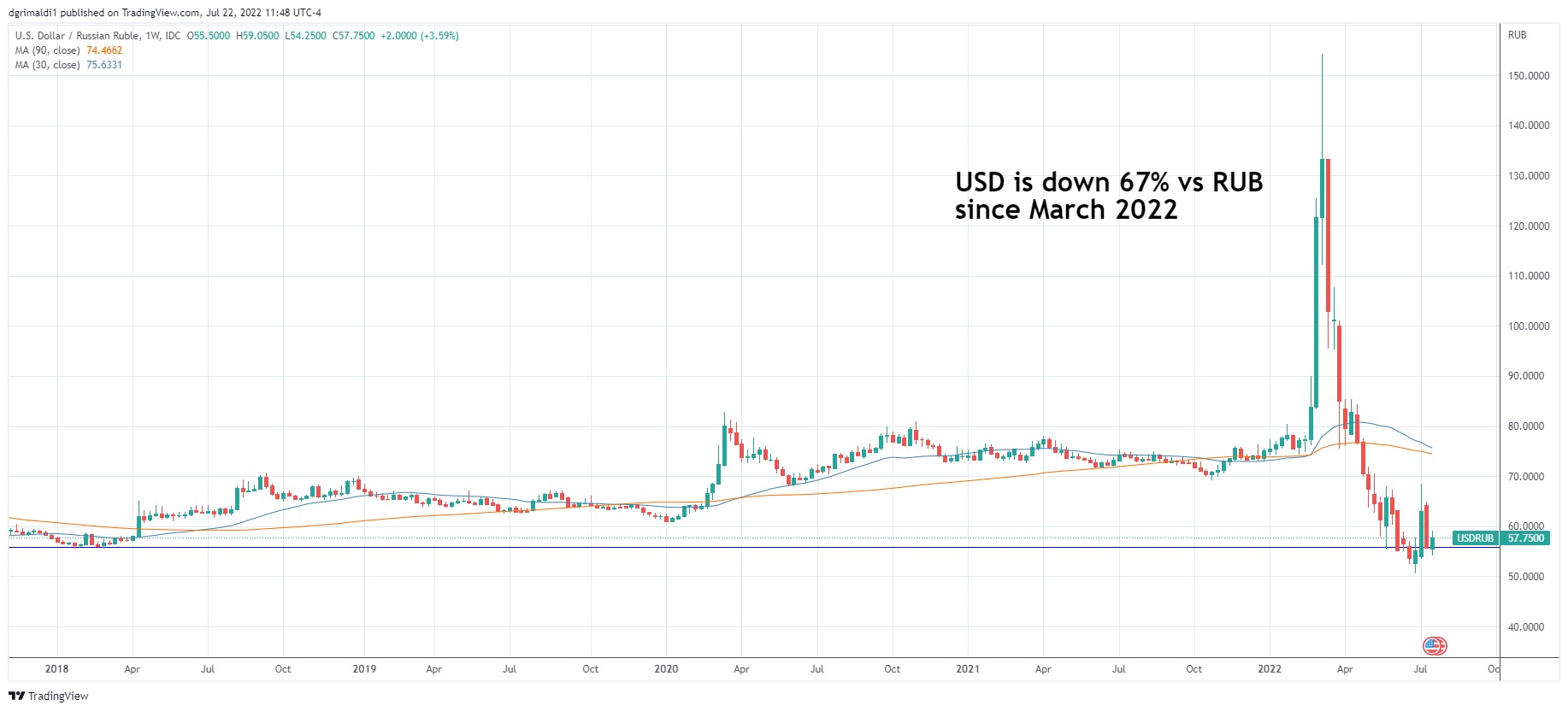
I thought it was worth looking at this chart because what you see on the news does not reflect what is really going on in Russia. Russians are paying $3.54 per gallon for gas compared to $5.00 in the U.S.1 China and India are happy to take Russian gas and pay in rubles. India has received 34 million barrels of discounted Russian oil since Moscow invaded Ukraine on Feb. 24, according to Refinitiv Eikon data, more than tripling the value of total imports from Russia, including other products, compared with the same period of 2021.2 Ruble has risen as the Russians have been more methodical (and violent) in Ukraine and look like they will fulfill early predictions of victory, despite how much money we dangerously dump to support Ukraine. The ruble has fallen below levels from 2018. Banks are forbidden to speculate in Rubles, so the price reflects only the demand side for purchasing oil. The Russian citizens are not suffering from all the boycotts from Western companies, and public opinion has majority support in Putin. SWIFT sanctions never had any teeth as transactions continue to take place between Western and Russian banks. European leaders pledge to end Russian gas purchases this year, which looks to do more harm to Europe than Russia. Putin is now delivering low gas prices to its citizens, a strong ruble, and selling oil at inflated prices to the rest of the world.
Written by David Grimaldi, Foreign Exchange Sales Consultant
Important disclosure information
The views, opinions and positions expressed are those of the referenced authors at the time of publication and are based upon information available at that time. There can be no assurance that any of the beliefs and views expressed herein will prove to be accurate, and actual outcomes or events may vary significantly from those presented. The authors’ views are subject to change and do not reflect the views, opinions or positions of Synovus Financial Corp, who makes no representations as to accuracy, completeness, timeliness, suitability or validity of information presented and will not be liable for any errors, omissions, or delays in this information or any losses, injuries or damages arising from its display or use. The information provided in this material is intended to highlight present economic and market conditions in general. It does not constitute any recommendation, and is not meant for use as personalized or individual investment advice. We encourage you to speak with your financial professional concerning your specific investment goals and risk tolerance before making investment decisions.
Investment products and services provided by Synovus are offered through Synovus Securities, Inc. (“SSI”), Synovus Trust Company, N.A. (“STC”) and Creative Financial Group, a division of SSI. Trust services are provided by Synovus Trust Company, N.A. The registered broker-dealer offering brokerage products for Synovus is Synovus Securities, Inc, member FINRA/SIPC and an SEC Registered Investment Advisor. SSI is a subsidiary of Synovus Financial Corp. and an affiliate of Synovus Bank and STC, and STC is a subsidiary of Synovus Bank.
Investment products and services are not FDIC insured, are not deposits of or other obligations of Synovus Bank, are not guaranteed by Synovus Bank and involve investment risk, including possible loss of principal amount invested. © 2022

